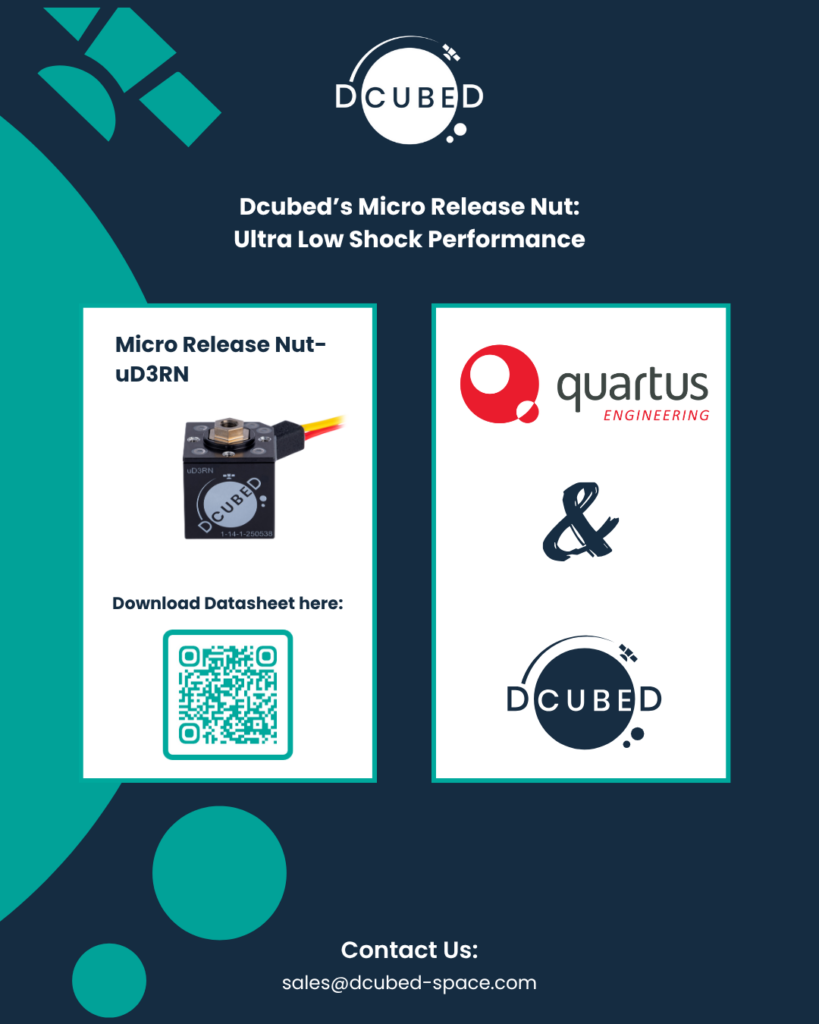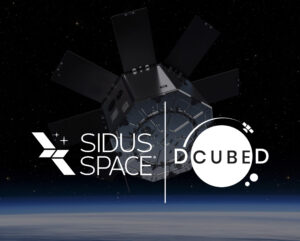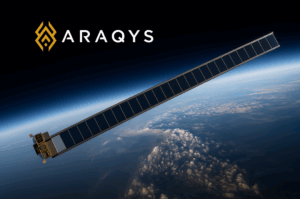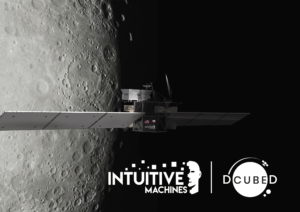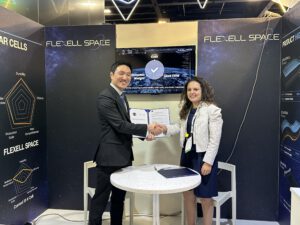June 2025
In an environment where precision and reliability are paramount, even the smallest mechanical components aboard a spacecraft can make or break mission success. That’s why the results of an independent test campaign by Quartus Engineering are welcome news—not just for the space engineers designing sensitive payloads, but also for Dcubed, the German-American company behind the micro release nut actuator at the heart of the study.
This thorough test campaign, presented at the 34th Aerospace Testing Seminar (ATS) in Los Angeles, CA, USA, evaluated the shock environment produced by the activation of Dcubed’s ultra-compact uD3RN HDRM—a resettable, shape memory alloy-based actuator designed for spacecraft hold-down and release applications. The goal: to validate the actuator’s induced shock performance under conditions closely replicating its actual use in flight.
The verdict? When done right, the uD3RN reliably separates under full preload while maintaining emitted shock levels well below critical thresholds—even under stringent measurement protocols. The findings confirm what Dcubed had long maintained: their micro actuator is among the lowest-shock HDRMs available for spacecraft applications.
Why It Matters
Modern space missions increasingly rely on delicate optical instruments and payloads that are highly sensitive to shock. Hold-down and release mechanisms (HDRMs) ensure that these components survive launch loads, only unlocking once safely in orbit. But release events themselves can generate shock levels capable of compromising system integrity. The challenge, therefore, is to ensure robust mechanical locking during launch—without inducing damaging shock loads upon separation.
Non-explosive actuators (NEAs) like Dcubed’s uD3RN offer a safer, more predictable alternative to traditional pyrotechnic mechanisms. But being compact and relatively new to market, data on their shock performance in realistic configurations had been limited—until now.
The Setup: Realistic Testing for Real Flight Conditions
Quartus Engineering designed the test campaign to mirror a flight-like configuration as closely as possible. Using “free-free” boundary conditions and flight-representative hardware interfaces—including a bimetallic Cup-Cone interface with captive feature, and a preload of 2 kN—the study captured the full mechanical picture, from release to impact.
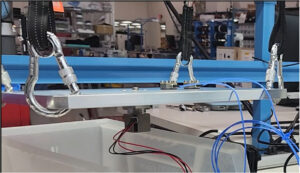
Figure 1. Typical test set-up.
A single resettable uD3RN device was subjected to multiple tests at different preload levels, with high-amplitude shock accelerometers measuring the highly-transient responses at over 100,000 samples per second. Special care was taken to identify shock sources, including a soft-catch scenario to separate the effects of the release from the impact of the released nut.
The initial findings were clear: while the release shock itself was ultra-low (SRS levels below 42g, not even getting above the noise level below 200Hz), a secondary impact event—caused by the nut striking the Cone—contributed the majority of the measured shock – see Figure 6 in the paper. This distinction proved crucial in refining the actuator’s configuration.
Engineering Insights: From Good to Outstanding
To improve performance, the team explored two avenues: reducing the secondary impact shock and enhancing separation reliability at lower preloads.
Replacing the standard polyacetal spacer with an elastomeric O-ring drastically reduced the impact shock—bringing SRS levels within striking distance of the ideal “soft catch” case. Simultaneously, adding a Belleville washer to assist with nut ejection greatly increased separation success, even at reduced preload levels.
The final “optimized configuration”—which combined both the Belleville spring and the O-ring—achieved the best of both worlds: Repeatable separations and significantly reduced shock levels. Peak accelerations remained below 100g, and SRS values stayed under 330g across the critical 10 Hz to 10 kHz frequency range (see figures 15 & 16 in the paper).
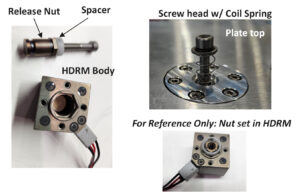
Figure 2. Optimized configuration.
Implications for Flight Hardware Designers
The study doesn’t just validate Dcubed’s product—it also provides an analytical framework and experimental benchmarks that spacecraft designers can use to assess HDRM risks more accurately. With a derived model linking preload to nut release velocity, engineers can now predict separation dynamics based on design parameters. This makes the uD3RN not just a component, but a predictable element within the spacecraft mechanical system.
One of the added values of working with a partner like Quartus Engineering is the ability to rapidly refine implementation methods with high confidence for future missions. Their development approach—grounded in over 25 years of simulation-driven engineering—enables fast iteration and precision optimization that aligns well with the pace and risk posture of today’s evolving space economy.
According to Alexander Cheff Halterman, Director of Technical Program Development, Quartus’ approach is anchored in high-end mechanical simulation in a collaborative engagement model.
“The exchange of information between Dcubed and Quartus enabled valuable physical insights critical to the success of this test campaign and the programs it supported. We look forward to building upon this successful work for future critical missions. Future collaborations between Dcubed, Quartus Engineering, and other mission stakeholders can build on this foundation—bringing the benefits of low-shock HDRM performance to new configurations with reduced schedule risk and enhanced design predictability.”
Dr. Markus Geiss, Commercial Director at Dcubed, agrees, emphasizing the value of third-party validation in a market where reliability is everything:
“We’re thrilled with the outcome of Quartus Engineering’s independent testing. It’s one thing for us to promote the ultra-low shock properties of our actuators, but having these claims confirmed by such a rigorous and flight-representative study is immensely valuable. It gives our customers hard data they can rely on and supports our mission to deliver reliable, compact, and resettable solutions for the space industry.”
Final Thoughts
In an industry where hardware is often separated by the finest margins of reliability and performance, Dcubed’s uD3RN Micro Release Nut has just taken a leap forward. Backed by independent data, its combination of ultra-low shock, repeatable separation, and compact design makes it a strong candidate for use in increasingly miniaturized and delicate space missions.
For spacecraft engineers looking to derisk mechanical deployment without trading off performance, these results are worth a close look.
Want to understand how Dcubed actuators can power the success of your next mission? Contact us at sales@dcubed-space.com!
